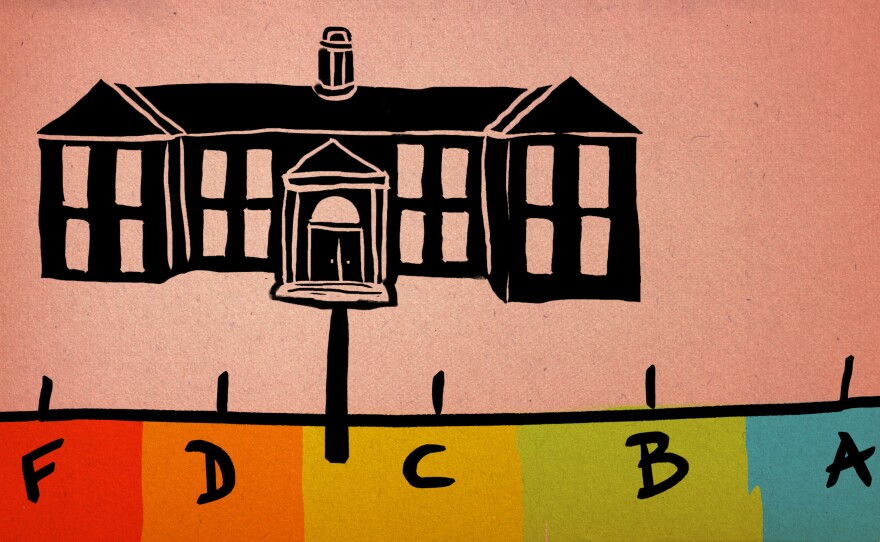Students aren't the only ones getting report cards these days. More than a dozen states now grade their public schools using the traditional A through F system. North Carolina is the latest to try it, and most of its high-poverty schools received D's and F's from the state education agency last week.
At Allen Middle School in Greensboro, N.C., nearly every student gets free or reduced-price meals. Between classes, preteens roam the bright hallways that are lined with inspirational quotes.
" 'A man can't ride your back unless it's bent,' " says Principal Sheila Gorham, reading one of her favorite quotes from the Rev. Martin Luther King Jr.
"So straighten up," she says. "So you don't have to worry about people fussing."
Two years ago, Allen Middle School was told to straighten up. Students here had been performing so poorly that the district forced everyone — from teachers to custodians — to re-apply for their jobs.
After the shake-up, students did show improvement, but their test scores are still relatively low. When asked what grade her school should have gotten last week from the state, Gorham exclaims:
"That's a good question! If it was up to me ... I would say a B."
The school got a D. Almost 30 percent of public schools in North Carolina got the same or worse.
"These grades are not as bad as many people thought they would be, and they are not as good as we want them to be," says June Atkinson, the state's superintendent of public instruction.
The letter grades for elementary and middle schools depend largely on how students perform on standardized tests. And that's led to criticism from educators and advocacy groups that the system doesn't adequately reflect how much kids at schools like Allen Middle have improved year-over-year.
In the state's formula, 80 percent of the grade is based on student achievement on tests, while 20 percent is based on student growth.
"The only thing these grades tell us is where the poor children go to school and where the rich children go to school," says Lynn Shoemaker, a former teacher who represents the advocacy group Public Schools First NC.
Shoemaker argues a school's grade doesn't account for poverty or budget cuts.
"It doesn't reflect the fewer classroom teacher assistants or the enormous class sizes that lack basic resources like textbooks and desks," she says.
The new grading system comes at a time when school choice is a big issue in North Carolina. Charter schools are growing, and the state is fighting a legal battle over its private school voucher program.
As part of the new policy, public schools have to post their grades on their websites. Schools that get D's or F's also have to send letters home to parents, telling them about the score.
"We're not asking to post a big marker outside that says 'WELCOME, WE'RE AN F SCHOOL,' " says Jerry Tillman, a long-time Republican state senator. "But you know the real world is, this is what you're achieving."
Tillman, who is also a retired teacher and school administrator, was a lead proponent of the new grading law. But the idea dates back to the late 1990s, when Florida's then-governor, Jeb Bush, implemented a grading system there.
Bush touted it as an important way to involve parents and spur improvement in struggling schools. The state ultimately saw a drop in its share of D and F schools but only after it made significant changes to the grading formula. New York City, under new leadership, threw out its A-F policy late last year.
Some states attach high stakes to the grades, using them to inform decisions about funding, rewards and takeovers. In North Carolina, though, Tillman says, the state can't do much to help any of the newly labeled D and F schools and that change, for now, has to come from the bottom up.
"If I'm a principal of a D school or an F school, I'm going to bust my fanny not to be [on that list] again next year," says Tillman, who admits he's open to the idea of changing the way schools are graded — to give more weight to student improvement — but not anytime soon.
That doesn't help parent Natasha Pace, who has a seventh-grader at Allen Middle School. She says the new grading system is discouraging.
"Now it feels like we took five steps forward to take four steps back," Natasha says. "We felt so good about our growth ... and now you tell us: What you did was not good enough."
Natasha is also a volunteer at Allen. Her job this week: help photocopy the letter to parents that says their kids' school isn't making the grade.
Copyright 2022 North Carolina Public Radio. To see more, visit North Carolina Public Radio. 9(MDAzMjM2NDYzMDEyMzc1Njk5NjAxNzY3OQ001))






